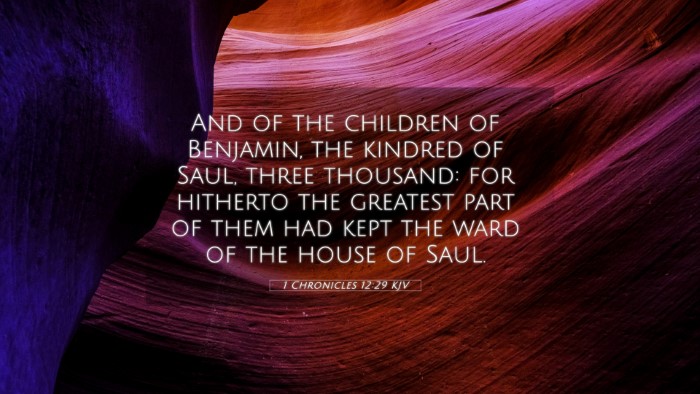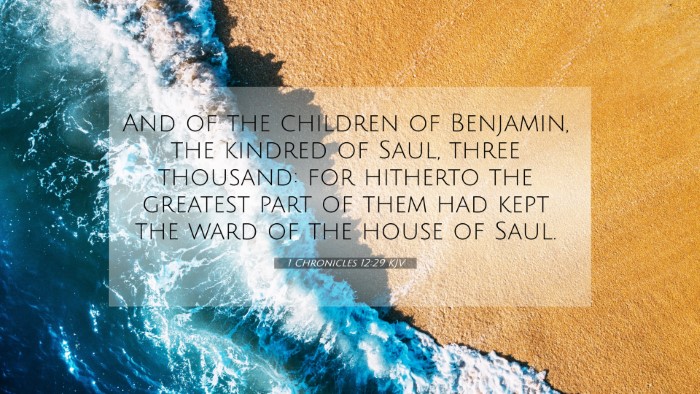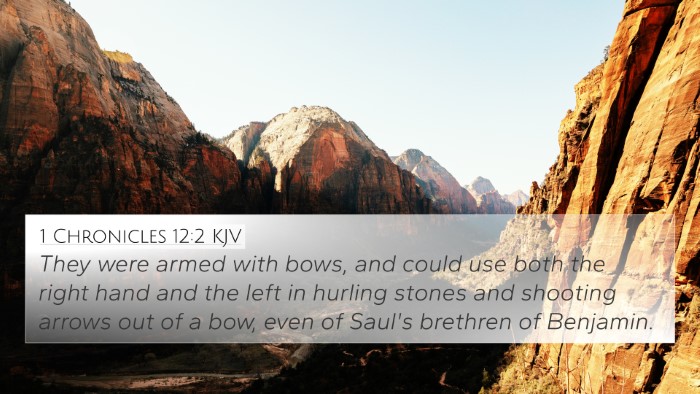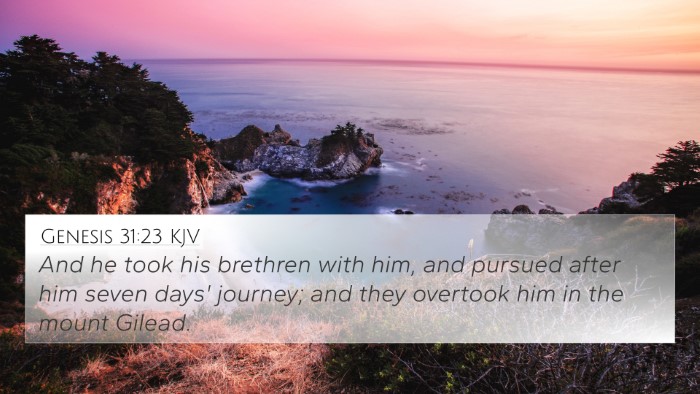Understanding 1 Chronicles 12:29
This verse states: "And of the children of Benjamin, the kindred of Saul, three thousand: for hitherto the greatest part of them had kept the ward of the house of Saul."
In this passage, we discover a crucial moment in the history of the Israelite nation, particularly regarding the transition of leadership from Saul to David. The verse specifically refers to the tribe of Benjamin and its loyalty to King Saul.
Summary of 1 Chronicles 12:29
- Contextual Importance: This verse is located within a narrative that details the tribes of Israel that supported David as he ascended to the kingship. The verse highlights the complex political and familial loyalties that existed during this time of transition.
- Benjamin's Loyalty: The mention of the children of Benjamin as supporters of Saul indicates the deep-seated regional and familial loyalties that were prevalent in Israel's early monarchy.
- Significance of Saul's House: By retaining a significant part of Saul's household and supporters, this illustrates the challenges David faced as he sought to unite the tribes under his rule.
Commentary Insights
Insights from public domain commentaries offer a deeper understanding of this verse:
- Matthew Henry: Henry emphasizes the theme of loyalty, noting how difficult it was for many to shift their allegiance from Saul to David. He points out the necessity of understanding the historical context to appreciate the complexities of the tribal loyalties in Israel.
- Albert Barnes: Barnes focuses on the numerical significance of the warriors from the tribe of Benjamin, suggesting that their numbers highlight the strength and influence of those remaining supporters of Saul's reign—implying a potential source of conflict for David.
- Adam Clarke: Clarke elaborates on the implications of Benjamin's allegiance, hinting at future tensions and the ongoing division of loyalties, which would be a recurring theme in the history of Israel.
Bible Cross-References
Several other Bible verses can enhance the understanding of 1 Chronicles 12:29 by providing context, parallels, and deeper themes:
- 1 Samuel 10:20-21: God’s selection of Saul and the tribal divisions present at the anointing of kings.
- 2 Samuel 2:8-10: The continuation of Saul’s family and the conflict arising from their claim to the throne following his death.
- Romans 11:1: Paul speaks of Israel's future, hinting at the lasting significance of the tribes, including Benjamin.
- Genesis 49:27: Jacob’s prophecy over Benjamin reflects on the nature of this tribe and its historical role in Israel.
- 1 Chronicles 12:2: Lists warriors from various tribes, showcasing the military strength necessary for David’s kingship.
- Matthew 1:12: References the lineage of Judah and Benjamin, further connecting the tribes to the overarching narrative of Israel’s history.
- Acts 13:21-22: Paul recounts the transition of leadership from Saul to David in his sermon, illustrating theological implications of this shift.
Thematic Bible Verse Connections
Exploring the themes of loyalty and political struggle, we find interconnections in the following verses:
- 2 Samuel 3:1: The ongoing war between the houses of Saul and David.
- Luke 22:30: Jesus speaks of his disciples as rulers in the coming kingdom, drawing parallels to the loyalties in the Old Testament.
Tools for Bible Cross-Referencing
Understanding passages like 1 Chronicles 12:29 can be enhanced through various tools and methods:
- Bible Concordance: A helpful reference to find topical connections and verses that resonate with specific themes.
- Bible Cross-Reference Guide: Guides that analyze inter-Biblical relationships and thematic developments across scriptures.
- Cross-Reference Bible Study: Using systematic study methods to explore links between verses, enriching personal and communal Bible study.
Conclusion
The exploration of 1 Chronicles 12:29 not only reveals the historical context of the Israelite monarchy but also invites further investigation through cross-referencing and thematic connections with other scriptures. The interplay of loyalty, political transition, and tribal allegiance is a microcosm of larger biblical themes that resonate throughout scripture.





